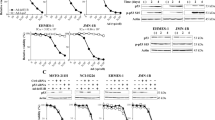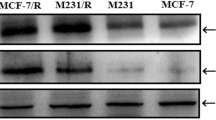Abstract
Expression of survivin has been reported to be correlated with shorter survival in patients with non-small cell lung cancer (NSCLC), and overexpression of survivin may lead to radioresistance in various human cancers. In this study, we inhibited survivin expression by using an adenoviral vector (AdsiSurvivin)-mediated RNA interference to elucidate the combined effect of survivin-targeting gene therapy and radiotherapy on the NSCLC cells. Our data showed that AdsiSurvivin exerted survivin gene silencing, induced apoptosis, and significantly attenuated the growth potential in NSCLC cells within 72 h after infection. The combined treatment modalities with AdsiSurvivin infection and radiation were significantly more potent on cell-growth inhibition than monotherapy. In H1650, H460, A549, and H1975 human NSCLC cells, the survival ratios of AdsiSurvivin-treated groups at multiplicity of infection of 25 and 50 were significantly lower than those of control groups at varying radiation dose (0–8 Gy; three-way analysis of variance, P<0.05). The cytotoxicity of combined AdsiSurvivin infection and irradiation increased in a dose-dependent manner in both the virus and the irradiation treatment. Knockdown of the survivin gene expression seems to be a promising treatment strategy for NSCLC. Our data warrant the need for further effort to develop survivin-targeted radiosensitizer for lung cancer treatment.
This is a preview of subscription content, access via your institution
Access options
Subscribe to this journal
Receive 12 print issues and online access
$259.00 per year
only $21.58 per issue
Buy this article
- Purchase on Springer Link
- Instant access to full article PDF
Prices may be subject to local taxes which are calculated during checkout







Similar content being viewed by others
References
Pennati M, Folini M, Zaffaroni N . Targeting survivin in cancer therapy. Expert Opin Ther Targets 2008; 12: 463–476.
Ambrosini G, Adida C, Altieri DC . A novel anti-apoptosis gene, survivin, expressed in cancer and lymphoma. Nat Med 1997; 3: 917–921.
Monzo M, Rosell R, Felip E, Astudillo J, Sanchez JJ, Maestre J et al. A novel anti-apoptosis gene: re-expression of survivin messenger RNA as a prognosis marker in non-small-cell lung cancers. J Clin Oncol 1999; 17: 2100–2104.
Lu CD, Altieri DC, Tanigawa N . Expression of a novel antiapoptosis gene, survivin, correlated with tumor cell apoptosis and p53 accumulation in gastric carcinomas. Cancer Res 1998; 58: 1808–1812.
Kawasaki H, Toyoda M, Shinohara H, Okuda J, Watanabe I, Yamamoto T et al. Expression of survivin correlates with apoptosis, proliferation, and angiogenesis during human colorectal tumorigenesis. Cancer 2001; 91: 2026–2032.
Li F, Ambrosini G, Chu EY, Plescia J, Tognin S, Marchisio PC et al. Control of apoptosis and mitotic spindle checkpoint by survivin. Nature 1998; 396: 580–584.
Jaattela M . Escaping cell death: survival proteins in cancer. Exp Cell Res 1999; 248: 30–43.
Suzuki A, Hayashida M, Ito T, Kawano H, Nakano T, Miura M et al. Survivin initiates cell cycle entry by the competitive interaction with Cdk4/p16(INK4a) and Cdk2/cyclin E complex activation. Oncogene 2000; 19: 3225–3234.
Kami K, Doi R, Koizumi M, Toyoda E, Mori T, Ito D et al. Downregulation of survivin by siRNA diminishes radioresistance of pancreatic cancer cells. Surgery 2005; 138: 299–305.
Lu B, Mu Y, Cao C, Zeng F, Schneider S, Tan J et al. Survivin as a therapeutic target for radiation sensitization in lung cancer. Cancer Res 2004; 64: 2840–2845.
McLaughlin N, Annabi B, Bouzeghrane M, Temme A, Bahary JP, Moumdjian R et al. The Survivin-mediated radioresistant phenotype of glioblastomas is regulated by RhoA and inhibited by the green tea polyphenol (−)-epigallocatechin-3-gallate. Brain Res 2006; 1071: 1–9.
Rodel F, Hoffmann J, Distel L, Herrmann M, Noisternig T, Papadopoulos T et al. Survivin as a radioresistance factor, and prognostic and therapeutic target for radiotherapy in rectal cancer. Cancer Res 2005; 65: 4881–4887.
Chakravarti A, Zhai GG, Zhang M, Malhotra R, Latham DE, Delaney MA et al. Survivin enhances radiation resistance in primary human glioblastoma cells via caspase-independent mechanisms. Oncogene 2004; 23: 7494–7506.
Asanuma K, Moriai R, Yajima T, Yagihashi A, Yamada M, Kobayashi D et al. Survivin as a radioresistance factor in pancreatic cancer. Jpn J Cancer Res 2000; 91: 1204–1209.
Mountain CF . Prognostic implications of the International Staging System for Lung Cancer. Semin Oncol 1988; 15: 236–245.
Perez CA, Stanley K, Grundy G, Hanson W, Rubin P, Kramer S et al. Impact of irradiation technique and tumor extent in tumor control and survival of patients with unresectable non-oat cell carcinoma of the lung: report by the Radiation Therapy Oncology Group. Cancer 1982; 50: 1091–1099.
Damstrup L, Poulsen HS . Review of the curative role of radiotherapy in the treatment of non-small cell lung cancer. Lung Cancer 1994; 11: 153–178.
Jett JR, Schild SE, Keith RL, Kesler KA . Treatment of non-small cell lung cancer, stage IIIB: ACCP evidence-based clinical practice guidelines (2nd edition). Chest 2007; 132 (3 Suppl): 266S–276S.
Herbst RS, O’Reilly MS . The rationale and potential of combining novel biologic therapies with radiotherapy: focus on non-small cell lung cancer. Semin Oncol 2003; 30 (4 Suppl 9): 113–123.
Kshivets O . Non-small cell lung cancer. The role of chemoimmunoradiotherapy after surgery. J Exp Clin Cancer Res 2001; 20: 491–503.
Adusumilli PS, Stiles BM, Chan MK, Chou TC, Wong RJ, Rusch VW et al. Radiation therapy potentiates effective oncolytic viral therapy in the treatment of lung cancer. Ann Thorac Surg 2005; 80: 409–416; discussion 416-407.
Zhang X, Cheung RM, Komaki R, Fang B, Chang JY . Radiotherapy sensitization by tumor-specific TRAIL gene targeting improves survival of mice bearing human non-small cell lung cancer. Clin Cancer Res 2005; 11: 6657–6668.
Tamm I, Wang Y, Sausville E, Scudiero DA, Vigna N, Oltersdorf T et al. IAP-family protein survivin inhibits caspase activity and apoptosis induced by Fas (CD95), Bax, caspases, and anticancer drugs. Cancer Res 1998; 58: 5315–5320.
Shi Y . Mammalian RNAi for the masses. Trends Genet 2003; 19: 9–12.
Chung YM, Yoo YD, Park JK, Kim YT, Kim HJ . Increased expression of peroxiredoxin II confers resistance to cisplatin. Anticancer Res 2001; 21 (2A): 1129–1133.
He TC, Zhou S, Da Costa LT, Yu J, Kinzler KW, Vogelstein B . A simplified system for generating recombinant adenovirus. Proc Natl Acad Sci USA 1997; 95: 2509–2541.
Yang CT, You L, Yeh CC, Chang JW, Zhang F, McCormick F et al. Adenovirus-mediated p14(ARF) gene transfer in human mesothelioma cells. J Natl Cancer Inst 2000; 92: 636–641.
Yang CT, You L LY, Lin CL, Mccormick F, Jablons DM . A comparison analysis of anti-tumor efficacy of adenoviral gene replacement therapy (p14ARF and p16INK4A) in human mesothelioma cells. Anticancer Res 2003; 23 (1A): 33–38.
Chen C, Ridzon DA, Broomer AJ, Zhou Z, Lee DH, Nguyen JT et al. Real-time quantification of microRNAs by stem-loop RT-PCR. Nucleic Acids Res 2005; 33: e179.
Wersto RP, Rosenthal ER, Seth PK, Eissa NT, Donahue RE . Recombinant, replication-defective adenovirus gene transfer vectors induce cell cycle dysregulation and inappropriate expression of cyclin proteins. J Virol 1998; 72: 9491–9502.
Teramoto S, Johnson LG, Huang W, Leigh MW, Boucher RC . Effect of adenoviral vector infection on cell proliferation in cultured primary human airway epithelial cells. Hum Gene Ther 1995; 6: 1045–1053.
Brand K, Klocke R, Possling A, Paul D, Strauss M . Induction of apoptosis and G2/M arrest by infection with replication-deficient adenovirus at high multiplicity of infection. Gene Ther 1999; 6: 1054–1063.
Smith W, Khuri FR . The care of the lung cancer patient in the 21st century: a new age. Semin Oncol 2004; 31 (2 Suppl 4): 11–15.
Sequist LV, Lynch TJ . EGFR tyrosine kinase inhibitors in lung cancer: an evolving story. Annu Rev Med 2008; 59: 429–442.
Murdoch D, Sager J . Will targeted therapy hold its promise? An evidence-based review. Curr Opin Oncol 2008; 20: 104–111.
Yang CH . EGFR tyrosine kinase inhibitors for the treatment of NSCLC in East Asia: present and future. Lung Cancer 2008; 60 (Suppl 2): S23–S30.
Shinohara ET, Hallahan DE, Lu B . The use of antisense oligonucleotides in evaluating Survivin as a therapeutic target for radiation sensitization in lung cancer. Biol Proced Online 2004; 6: 250–256.
Uchida H, Tanaka T, Sasaki K, Kato K, Dehari H, Ito Y et al. Adenovirus-mediated transfer of siRNA against survivin induced apoptosis and attenuated tumor cell growth in vitro and in vivo. Mol Ther 2004; 10: 162–171.
Acknowledgements
This study was supported by the Grant No. 93-2320-B-182-034 from National Science Council, Taiwan, R.O.C. to C-T Yang.
Author information
Authors and Affiliations
Corresponding author
Rights and permissions
About this article
Cite this article
Yang, CT., Li, JM., Weng, HH. et al. Adenovirus-mediated transfer of siRNA against survivin enhances the radiosensitivity of human non-small cell lung cancer cells. Cancer Gene Ther 17, 120–130 (2010). https://doi.org/10.1038/cgt.2009.55
Received:
Revised:
Accepted:
Published:
Issue Date:
DOI: https://doi.org/10.1038/cgt.2009.55
Keywords
This article is cited by
-
Cancer therapeutics using survivin BIRC5 as a target: what can we do after over two decades of study?
Journal of Experimental & Clinical Cancer Research (2019)
-
Stomatin-like protein 2 regulates survivin expression in non-small cell lung cancer cells through β-catenin signaling pathway
Cell Death & Disease (2018)
-
Inhibitors of apoptosis: clinical implications in cancer
Apoptosis (2017)
-
Chidamide alleviates TGF-β-induced epithelial–mesenchymal transition in lung cancer cell lines
Molecular Biology Reports (2016)
-
Small-molecule survivin inhibitor YM155 enhances radiosensitization in esophageal squamous cell carcinoma by the abrogation of G2 checkpoint and suppression of homologous recombination repair
Journal of Hematology & Oncology (2014)



